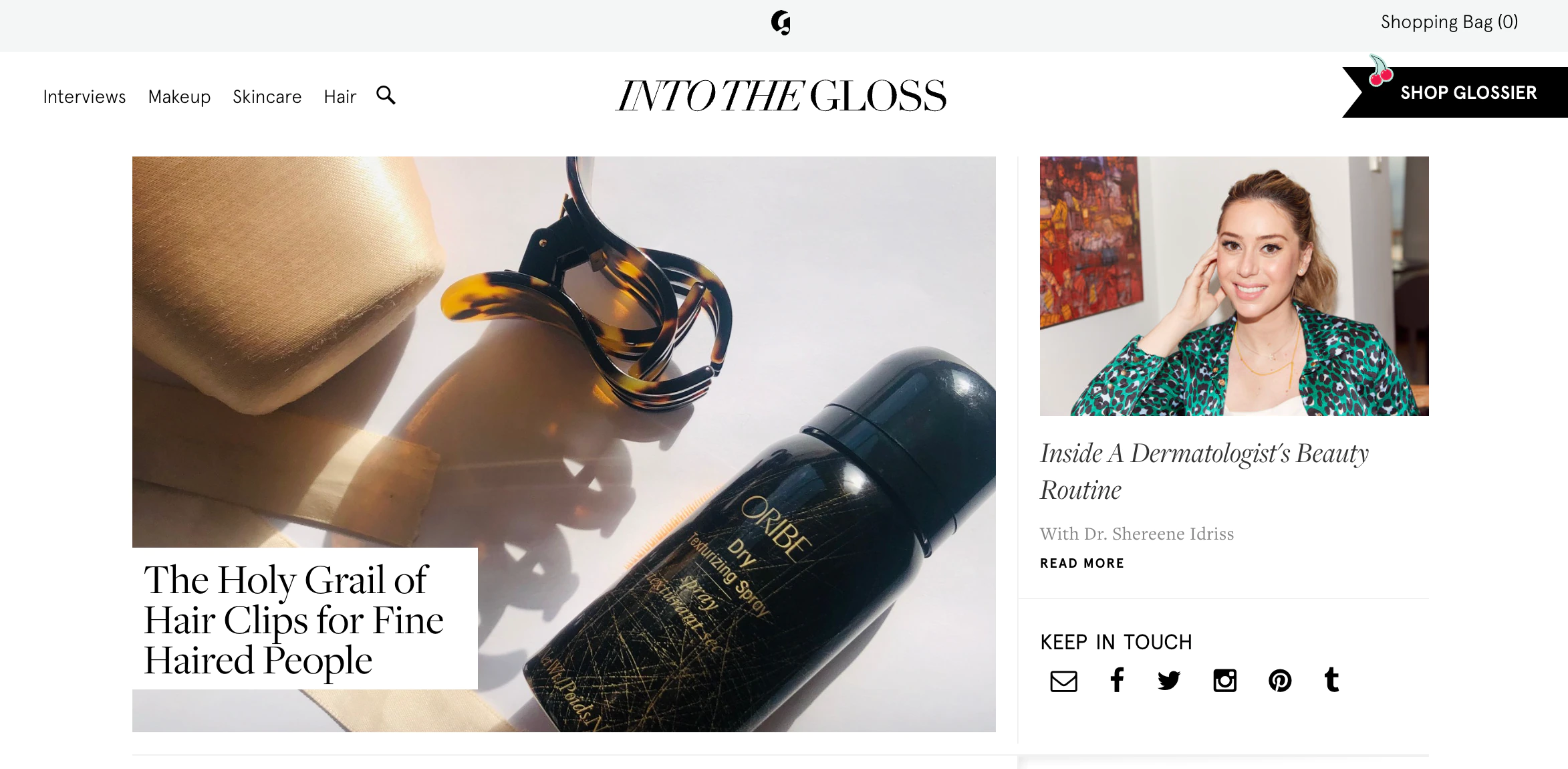
Into The Gloss, the once wildly popular beauty website and launchpad for Glossier that was created by Emily Weiss, hasn’t published a new post in nearly four months.
On Twitter Tuesday afternoon, writer Mattie Kahn brought the fact to the beauty industry’s attention, tweeting, “Realized this afternoon when I was procrastinating that Into the Gloss stopped publishing in June! Inevitable, but I will miss it. Loved looking at all those psycho beauty routines. Each one a unique wacko jewel.”
A quick glance at Into the Gloss’ website shows that is indeed true. Liana Satenstein, a senior fashion writer at Vogue, was the subject of Into the Gloss’ most recent published post, a Top Shelf (one of the site’s best known story formats) from June. For those who don’t know, being the subject of a Top Shelf, “the best in beauty tips, makeup tutorials, product reviews, and techniques from industry leaders worldwide,” was a big deal. It denoted girl crush status, it meant “that is a cool girl, I want to be like her.”
It’s hard to say what’s more surprising – that Into the Gloss, or ITG, hasn’t published a story since June, or that it took that long for someone to point it out.
According to a Glossier spokesperson, the site’s editorial director was on maternity leave “up until very recently, which explains the lack of posts over the summer.”
“ITG isn’t going anywhere,” read an e-mail from the brand. “You can expect to see more from us later in October.”
ITG, which launched in 2011, was a publishing pioneer. From the start, the site was able to nab big beauty advertisers like Lancôme, something that previously only magazines and the websites of magazines owned by Condé Nast, Hearst or any other publishing giant could do. In ITG’s earliest days, Weiss partnered with Coach and Bumble & Bumble, which is owned by multi-billion-dollar beauty conglomerate The Estée Lauder Companies.
Weiss and ITG’s ascension came at a pivotal time. Bloggers were just starting to be taken seriously — despite objections from traditional magazine editors whose relevance diminished as people like Weiss’ star rose — but their presence was mostly limited to personal or street style blogs. Weiss had the perfect pedigree, too: she attended New York University; interned at Teen Vogue, which was documented in MTV’s “The Hills” (where Weiss famously became known as “Super Intern”) and worked at W magazine before starting ITG.
Weiss was one of a few who were able to leverage their industry influence and web sites into bonafide media properties, replete with a full staff, big name advertisers, sponsored content deals, product collaborations and content that was actually good. The others included Leandra Medine Cohen, who started fashion site Man Repeller in 2010, and The Coveteur, a lifestyle site that married fashion and home décor with a very specific aesthetic that was equally as elevated as ITG’s. Having your house (or apartment if you were based in New York City) photographed and featured on The Coveteur was the in-home equivalent of detailing your beauty routine for The Top Shelf. (Man Repeller ceased publishing in October 2020, The Coveteur is still operational.)
Over the years, the site’s minimalist aesthetic and insider approach to content was knocked off by too many websites, brands and bloggers to count. ITG always felt elevated and aspirational, and even the biggest publishing companies tried to re-create their own version of Weiss’ vision.
In a 2012 BoF article, Weiss, who was 27 at the time, talked about a collaboration with Bumble & Bumble to debut a new product, Hairdresser’s Invisible Oil, which included a successful sampling program. ITG wound up becoming the third biggest traffic driver to the bumbleandbumble.com, and Invisible Oil became a top seller for the hair care brand. As if foreshadowing what would come two years later with the launch of Glossier, BoF editor-in-chief Imran Amed wrote, “Indeed, with this kind of power to move product, Into The Gloss could one day become an e-commerce success of its own.”
But perhaps most importantly, the site became a blueprint for how brands could use content to inform commerce. Weiss cultivated a rabid fan base, a group that ultimately became the best focus group and launch pad a founder could ask for. Commenters were influential in Glossier’s product development and the creation of new products, serving as a sounding board for Weiss and her team. This “community-first” approach became a pillar of Glossier, which went from a direct-to-consumer label Weiss had trouble convincing people to invest in to a beauty brand with an almost $2 billion valuation.
Glossier is also in the midst of a rough patch. In January, the brand laid off 80 employees and in May, Weiss stepped down as chief executive officer and moved into executive chairwoman role, and Kyle Leahy, an alum of Nike, Cole Haan and American Express, became the brand’s new chief executive. The change in leadership followed two years of declining sales, layoffs and a miss with Glossier Play, an expensive experiment in bolder makeup that both failed to resonate with the brand’s customers or attract new ones. Glossier has struggled to scale and attract new consumers; customer acquisition online got very expensive and the company was reluctant to enter into wholesale partnerships. Its dedication to a direct-to-consumer selling model, driven by its e-commerce site and a handful of physical stores, which initially set the brand apart, began to hold it back.
In July, Glossier announced that it would enter Sephora stores early next year, which presents an entirely new set of challenges for a brand that’s sold predominantly online, through its own site, since 2014.
While Glossier matured from cute startup to a company that employed hundreds, Weiss’ original beauty destination reached a crossroads. As Glossier grew, less attention was paid to ITG – and its publishing cadence suffered as a result. The site’s future became less certain as the line between running a brand and media property blurred. How can ITG retain editorial independence from the beauty line born out of it — and does it even need to? Can ITG be a separate entity from Glossier or are the two forever entwined?
Plus, when it comes to content, the industry went through another critical platform evolution. Instagram and TikTok displaced ITG’s insider-feeling beauty coverage. Like any other lifestyle content, it’s democratised by the individual now.
Today, people will simply tell you about their ridiculous beauty routines themselves on TikTok or Instagram.


